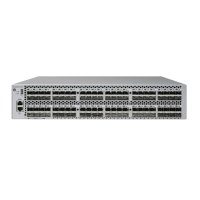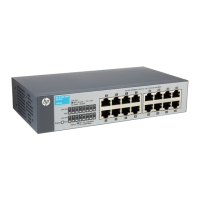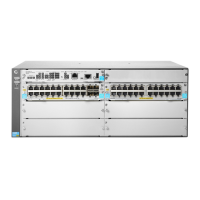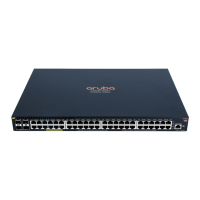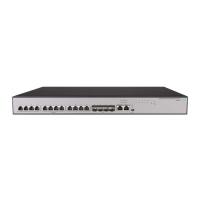118
different values. For compatibility with a neighbor device, configure the TPID value on the
device to be the same as the neighbor device.
• Priority—3-bit long, identifies the 802.1p priority of the frame. For more information, see ACL
and QoS Configuration Guide.
• CFI—1-bit long canonical format indicator that indicates whether the MAC addresses are
encapsulated in the standard format when packets are transmitted across different media.
Available values include:
{ 0 (default)—The MAC addresses are encapsulated in the standard format.
{ 1—The MAC addresses are encapsulated in a nonstandard format.
This field is always set to 0 for Ethernet.
• VLAN ID—12-bit long, identifies the VLAN to which the frame belongs. The VLAN ID range is 0
to 4095. VLAN IDs 0 and 4095 are reserved, and VLAN IDs 1 to 4094 are user configurable.
The way a network device handles an incoming frame depends on whether the frame has a
VLAN-tag and the value of the VLAN tag (if any). For more information, see "Introduction."
Ethernet supports encapsulation formats Ethernet II, 802.3/802.2 LLC, 802.3/802.2 SNAP, and
802.3 raw. The Ethernet II encapsulation format is used here. For information about the VLAN tag
fields in other frame encapsulation formats, see related protocols and standards.
For a frame with multiple VLAN tags, the device handles it according to its outer-most VLAN tag and
transmits its inner VLAN tags as the payload.
Protocols and standards
IEEE 802.1Q, IEEE Standard for Local and Metropolitan Area Networks: Virtual Bridged Local Area
Networks
Configuring basic VLAN settings
Step Command Remarks
1. Enter system view.
system-view
N/A
2. (Optional.) Create a
VLAN and enter its
view, or create a list of
VLANs.
vlan
{ vlan-id1 [
to
vlan-id2 ] |
all
}
By default, only the system default VLAN
(VLAN 1) exists.
3. Enter VLAN view.
vlan
vlan-id
To configure a VLAN after you create a list
of VLANs, you must perform this step.
4. Configure a name for
the VLAN.
name
text
By default, VLAN names are in the format
VLAN
vlan-id. For example, the name of
VLAN 100 is
VLAN 0100
by default.
5. Configure the
description of the
VLAN.
description
text
The default setting is VLAN vlan-id, which
is the ID of the VLAN. For example, the
description of VLAN 100 is
VLAN 0100
by
default.
NOTE:
• As the system default VLAN, VLAN 1 cannot be created or deleted.
• Before you delete a dynamic VLAN, a VLAN configured with the QoS policy, or a VLAN locked by
an application, you must first remove the configuration from the VLAN.

